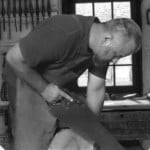Veritas Skewed Rabbet Plane
Welcome! / Forums / General Woodworking Discussions / Tools and Tool Maintenance/Restoration / Veritas Skewed Rabbet Plane
- This topic has 20 replies, 7 voices, and was last updated 4 years, 10 months ago by
Larry Geib.
-
AuthorPosts
-
 20 August 2015 at 3:34 am #129537
20 August 2015 at 3:34 am #129537Probably my least most used tool but when I need it it’s my favourite mostly because of it’s skewed blade. It works wonderfully across the grain but it is a frustrating tool to setup, I have tried several ways to do it and have constantly failed until today. The blade must be protruding the thickness of a sheet of paper on the side, what paper? the type your printer uses.
You have two set screws on the side they are the key to it all. Remove the lever cap and examine the screws, make a mental note of how each screw positions the blade. The top screw closest to the sole will retract the blade in or out from the side and the bottom screw will slightly do the same.
Make minute incremental turns on both while sighting down the sole of the plane until and you can judge by eye the protrusion of that thickness sheet of paper making sure the blade is parallel to the sole. I used David Charlesworth method for checking for parallel, a thin piece of wood dragging it on each side of the blade, looking, feeling as I drag that thin piece across the blade for equal drag and shavings all the while making the tiniest ever turns on the screws. If your blade is protruding too much on the left then adjust the bottom screw if on the right then the top all the while maintaining that protrusion on it’s side.
Yes it’s fiddly but once setup you will cut square rabbets and come time for sharpening the blade should return to the same position thanks to those set screws. That part I’m yet to find out and I’m hoping that will be the case.
 20 August 2015 at 6:57 pm #129569
20 August 2015 at 6:57 pm #129569I don’t have a dedicated rabbet plane, but if I did, a skewed blade would be nice. Thanks for your tutorial on setting it up.
 20 August 2015 at 9:15 pm #129574
20 August 2015 at 9:15 pm #129574I have the southpaw version and I agree, it’s one of my favourite tools to use. I found adding a longer auxiliary fence helps with the accuracy. I’ve also used it for raised panels by adding a angled fence. One other thing is to make sure the set screws ae snugged up before removing the blade for sharpening. I’ve had them move occasionally.
 20 August 2015 at 9:24 pm #129577
20 August 2015 at 9:24 pm #129577Thanks Pete for the heads up on those screws I will recheck them today. The only downside to this plane is keeping it square, some how even pressing against the fence I manage to tilt it to the right and I’m think I may be applying too much downward pressure behind the tote. I also made a fence but on this occasion I didn’t use it that could also be the reason for the tilt, I’ll try it out again some scrap.
 20 August 2015 at 10:18 pm #129579
20 August 2015 at 10:18 pm #129579The other thing I found for keeping thing square was to never use the front knob. I use one hand on the tote and the other on the fence, pushing it against the work. Also, I found that the hand on the tote is mostly just for pushing, ie hold the tote fairly loosely. It took me awhile to get the hang of it, but now it feels natural. There’s a bit of a learning curve (as with most hand tool techniques).
 20 August 2015 at 10:49 pm #129581
20 August 2015 at 10:49 pm #129581Much to my delight I made a perfect square rabbet and the key is the auxiliary fence I made for it, because it’s longer and wider so it remains constantly pressed and flat against the edge of the stock while the fence that comes with the plane is small and it’s very hard to tell whether or not you are flat up against the edge.
The only downside to using an attached fence is the width realestate you lose, I do have longer rods but they’re awkward and get in the way. I’m yet to find out whether or not holding the placing your finger behind the tote or holding the tote actually makes a difference.
I’m going to try this now, btw as I was planing a new possibility opened up to me, by rabbeting sequentially at varying depths one create shingles for a roof top.
 20 August 2015 at 11:03 pm #129582
20 August 2015 at 11:03 pm #129582Your right it don’t work so well holding onto the tote as your hand tends to tilt the plane to the right, I just had to try it to see why. I will definitely get the right version as well, I now literally don’t have anymore room in my tool cabinet which means I have to build a toolbox which I’ve been wanting to build for some time now. I was just wondering though won’t the chisel edges get damaged in the tray.
 20 August 2015 at 11:32 pm #129584
20 August 2015 at 11:32 pm #129584SALKO YOU should know there are three things you never have enough of tools toolboxs and wood
a wise man said
He who dies with the most tools wins
Frank J 21 August 2015 at 12:08 am #129585
21 August 2015 at 12:08 am #129585I’ve said to my son. Son you are never to sell my tools, they must go to your son or daughter if they’re interested in woodworking if not then it must be passed onto their kids all the while I’m hoping that this woodworking bloodline continues onto his kids so at least I can be around to teach them. Unfortunately my grandfather was not around to teach me and what my mother told me he had many workers and still found time to teach in schools. Imagine what I could of learned from him. Anyway that’s the plan.
 21 August 2015 at 3:15 am #129587
21 August 2015 at 3:15 am #129587This is a good idea, Salko. The desire may skip a generation or two, but its worth it. My great-grandfather was a cabinet maker, and my great aunt sold all his tools after he died. An entire barn-side shop full of tools. Two generations later, I wish I had those tools.
 21 August 2015 at 5:47 am #129588
21 August 2015 at 5:47 am #129588Sometimes necessity drives a person to do undesirable things but it’s common practice for the widow to sell her husband’s tools. This is why I am making sure that this doesn’t happen to my tools, it took me a long time and literally thousands of dollars to accumulate them and how many more am I going get and make. It would be a tragedy if they ended up on display on some tool collectors shelf or worse scrapped for metal. No,no not this boy I want someone in my family to use them either for hobby or to earn a living without the need to go to any expense in the acquisition of tools. Someone down the lineage will be born to workwood and hopefully work it by hand as I have no machinery to offer other than my bandsaw and scrollsaw.
My two greatest assets which is all my wealth I have to offer is my knowledge and tools, skill they have to get on their own but if I’m not around to pass this knowledge on I have journals I keep which they can refer to and learn from.
I genuinely feel obliged, incumbent upon me to pass this knowledge on in one form or another no matter how little or great it is because one day on that inevitable day when I stand before our Creator and He asks me what did you do with the knowledge I have given you I want to answer I have used it to earn an honest living, I have taught and still am teaching, I have passed it on.
To me that is true success, money is only transient but knowledge lives forever.

@salko @pjgeorge I found this old discussion about the LV skew rabbet plane. Can you tell me whether it does well cutting rabbets across the grain? In particular, does the nicker / scoring blade actually work? I have a #78, which I’ve just started experimenting with across the grain and find the nicker is not very good…too thick, too deep, and in the wrong place.
On the LV, can you adjust the nicker? If so, in what way? Depth? Projection away from the plane body? Ideally, you’d want the nicker to project sideways from the side of the plane body exactly as much as the blade. Can that be adjusted?
I don’t cut rabbets much, so I’ve never had to tune up my #78. All my cabinets, etc., have used panels in grooves, but now I’d like to be able to make some.
 19 June 2019 at 3:07 pm #582540
19 June 2019 at 3:07 pm #582540@ed The nicker is adjustable for both depth and projection. I’ve only adjusted the projection once and haven’t had to since. The plane works very well both with and across the grain.
If you go to the Lee Valley website, they have the instruction sheet and a video on setting up the plane.
Here’s a link to the page, and if you look under the first price line, you will see links to the instructions and the video.
http://www.leevalley.com/en/Wood/page.aspx?p=59999&cat=1,41182,48945&ap=1
@pjgeorge Very helpful. Thank you. There is one thing I cannot figure out about the nicker, even with the instructions. Suppose you want a rabbet all the way around a panel. You set the fence, nicker, and depth stop and then cut the cross grain rabbets. My question is, when you then move on to the long-grain rabbets, can you put the nicker into a neutral position without moving the depth stop or fence, or are they in the way? Ideally, you don’t want to move either, so that you keep the same setting.
I see some people complaining about the depth stop and fence moving, so they need pliers to tighten the various knobs. Do you find that to be necessary? Maybe they fixed this problem when they fixed the plow plane design?
-
AuthorPosts
- You must be logged in to reply to this topic.
